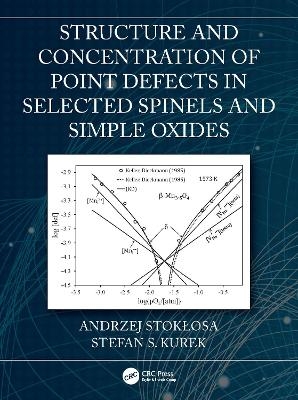
Structure and Concentration of Point Defects in Selected Spinels and Simple Oxides
CRC Press (Verlag)
978-0-367-61712-7 (ISBN)
Structure and Concentration of Point Defects in Selected Spinels and Simple Oxides presents diagrams and numerical data of important properties of spinels and oxides based on experimental results published in the literature. The values of many parameters presented can be used for optimization of preparation of new systems, to predict the practical properties of these systems. Applications include electronic devices, new metallic alloys with improved corrosion resistance, new ceramic materials, and novel catalysts, particularly for oxygen evolution and reduction reactions.
Organized into four comprehensive parts, the authors present the problem of the structure and concentration of ionic and electronic defects in magnetite and hausmannite, pure and doped with M3+ cations, and in spinels exhibiting magnetic properties and high electric conductance.
Additional Features include:
Includes 236 figures presenting equilibrium diagrams of point defects and other useful details related to stoichiometric and nonstoichiometric spinels and oxides.
Details novel methods of calculation of equilibria involving point defects.
Collects scattered data published in nearly 500 original articles since the 1950s on spinels and oxides in one useful volume.
Building upon the data presented, this book is an indispensable reference for material scientists and engineers developing new metal or oxide-based systems can easily calculate other useful parameters and compare the properties of different materials to select the best candidates for an intended use.
Andrzej Stokłosa is Professor Emeritus at Cracow University of Technology, Faculty of Chemical Engineering and Technology in Krakow, Poland. After receiving MSc degree in chemistry, at the Jagiellonian University in Krakow, he was employed at the AGH University of Mining and Metallurgy in Krakow in the Department of Solid State Chemistry in the group of Professor Stanisław Mrowec. He received his PhD degree in 1972, DSc (habilitation) degree in 1984. He moved to Cracow University of Technology in 1989 and became Head of Physical Chemistry Department as Associate Professor and was promoted to full professor position in 1992. Professor A. Stokłosa is an author and co-author of more than 150 scientific papers, the author of books: Non-Stoichiometric Oxides of 3d Metals (Trans. Tech. Pub. Pfaffikon, Switzerland, 2015 (Mat. Sci. Foundations 79 (2015)). "Basic Phenomenological and Statistical Thermodynamics", "Introduction to Physical Chemistry" and several other standard textbooks for students (in Polish). He has published in the area of solid state materials associated with crystallochemistry; structure and thermodynamics of point defects in metal oxides and sulfides; the defects and electronic structure modification for the use in electrochemical intercalation; kinetics and mechanism of catalytic and electrocatalytic reactions. Stefan S. Kurek is Assistant Professor at Cracow University of Technology in Krakow, Poland. He graduated from this University in 1974, and got his PhD in chemical technology there in 1982. He worked as postdoc in the UK, at the Universities of Birmingham and Bristol, on coordination compounds, including electron transfer from photoexcited porphyrins. Now, his research interests focus on molecular electrochemistry.
PART I Diagrams of the Concentrations of Point Defects for Pure and Doped Magnetite and Hausmannite Chapter 1 Magnetite Chapter 2 Hausmannite PART II Magnetite Doped with M3+ and M2+ ions Chapter 3 Titanium-Doped magnetite ・ (Fe1−xTix)3}δO4 Chapter 4 Chromium-Doped Magnetite ・ (Fe1−xCrx)3}δO4 Chapter 5 Aluminium-Doped Magnetite ・ (Fe1−xAlx)3−δO4 Chapter 6 Cobalt-Doped Magnetite ・ (Fe1−xCox)3}δO4 Chapter 7 Manganese-Doped Magnetite (Fe1−xMnx)3}δO4 Chapter 8 Magnetite Doped with Manganese and Cobalt ・ (CoxMnzFe2z)3}δO4 Chapter 9 Magnetite Doped with Zinc and Manganese ・ (Zn,Mn,Fe)3}δO4 Chapter 10 Effect of Dopants on the Concentrations of Point Defects and their Mobilities in Magnetite ・ a Summary PART III HAUSMANNITE DOPED WITH COBALT, IRON AND LITHIUM Chapter 11 Cobalt-Doped Hausmannite ・ (Mn1−xCox)3}δO4 Chapter 12 Iron-Doped Hausmannite ・ (Mn1−xFex)3}δO4 Chapter 13 Hausmannite Doped with Iron and Cobalt ・ (CoxFezMn2z)3}δO4 Chapter 14 Lithium-Manganese Spinel LiMn2O4 Chapter 15 Structure of Defects in Doped Hausmannite ・ Summary PART IV DIAGRAMS OF CONCENTRATIONS OF POINT DEFECTS IN OXIDE SOLID SOLUTIONS (FE1−XMX)1−δO (WHERE M = Mn AND Co) Chapter 16 Structure of Point Defects in Oxides Fe1−δO, Mn1−δO and Co1−δO Chapter 17 Manganese-Wustite (Fe1−xMnx)1−δO Chapter 18 Cobalt-Wustite ・ Halite (Fe1−xCox)1−δO
| Erscheinungsdatum | 12.04.2021 |
|---|---|
| Zusatzinfo | 13 Tables, black and white; 393 Line drawings, black and white; 393 Illustrations, black and white |
| Verlagsort | London |
| Sprache | englisch |
| Maße | 210 x 280 mm |
| Gewicht | 966 g |
| Themenwelt | Technik ► Elektrotechnik / Energietechnik |
| Technik ► Maschinenbau | |
| ISBN-10 | 0-367-61712-9 / 0367617129 |
| ISBN-13 | 978-0-367-61712-7 / 9780367617127 |
| Zustand | Neuware |
| Haben Sie eine Frage zum Produkt? |
aus dem Bereich


